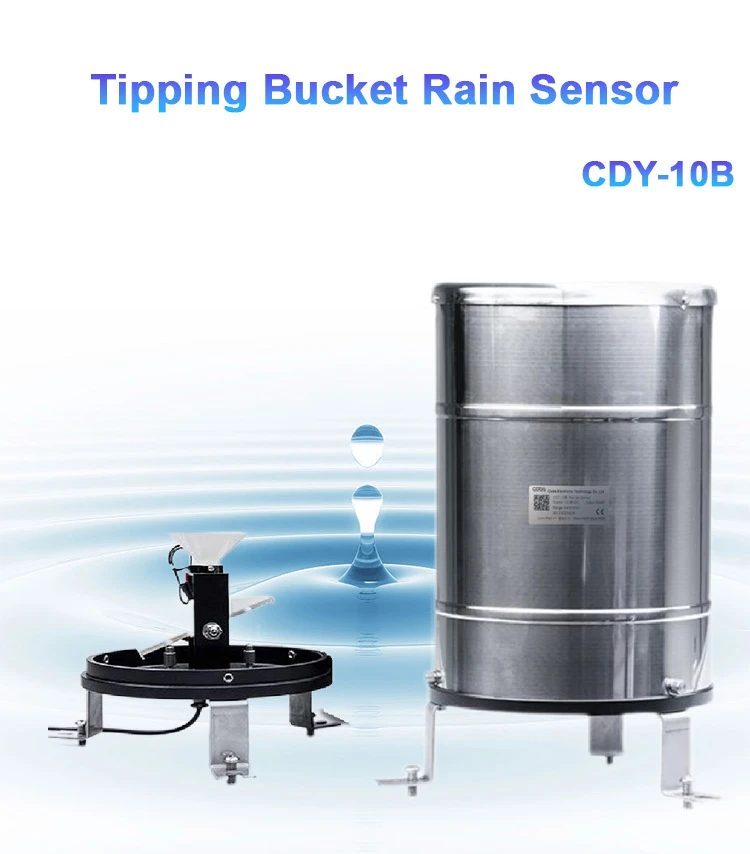Rain Sensor: Common Faults and Repair Methods
Rain sensors are valuable devices designed to detect rainfall, commonly applied in meteorological observations, hydrological monitoring, and automated control systems. Like any equipment, these sensors may experience certain malfunctions over time. Below are some common issues encountered with rain sensors and suggested methods for repairing them.
Common Faults in Tipping Bucket Rainfall Sensors
1. Sensor Fails to Detect Rainfall
Possible Causes: Power supply issues, damaged sensor, or faulty wiring.
Solutions:
Verify if the power supply is stable and properly connected.
Use a multimeter to check the sensor’s output signal for abnormalities.
2. Inaccurate Rainfall Detection
Possible Causes: Changed sensitivity, obstruction from dirt, or sensor damages.
Solutions:
Cleaning and Inspection: Ensure the rain funnel is free of obstructions and clean it thoroughly for smooth water flow. Check the connections between the sensor, collector, and other components to confirm they are intact and undamaged.
Sensitivity Adjustment: Re-calibrate the sensor’s sensitivity according to the manufacturer’s specifications.
Calibration Process: If you can, adjust the rainfall sensor. First, remove the outer metal casing. Then, loosen the screws to fine-tune the tipping mechanism. Calibrate tools to align values accurately after water flow tests, and repeat the process until you achieve precise readings.
3. Abnormal Output Signals
Possible Causes: Electrical signal instability or interference.
Solutions:
Inspect the sensor cables for damage or loose connections.
Use diagnostic tools such as an oscilloscope or logic analyzer to evaluate signal stability and detect potential interference.
4. Mechanical Component Failure
Possible Causes: Wear and tear on tipping mechanisms or other physical components.
Solutions:
Lubricate movable parts to ensure smooth operation.
Replace any worn-out or damaged mechanical components promptly.
5. Software or Firmware Issues
Possible Causes: Misconfigured settings or software glitches affecting data output.
Solutions:
Reinstall or update the firmware/software as needed.
Double-check sensor settings to ensure compatibility with measurement requirements.
Installation Tips for Long-Term Stability
Ensuring proper installation is key to a rain sensor’s reliable performance:
Positioning and Leveling: Install the device on a stable concrete base with pre-buried screws for firm fixation. Adjust the base to ensure the sensor remains level (use a built-in bubble level indicator).
Wiring Protection: Guide cables through the base’s designated round hole, securing them to terminal posts. Protect connecting components with sleeves or covers to prevent weather-related damage.
Common Faults in Piezoelectric Rain Sensors
1. Slow or No Response
Possible Causes: Dirt, dust, or rainfall residue on the sensor’s surface.
Solutions:
Clean the sensor regularly using a soft cloth. Avoid harsh chemical solvents that could damage sensitive components.
2. Inaccurate Readings or Data Drift
Possible Causes: Aging internal components or minor damages.
Solutions:
Examine internal components for wear or malfunctions. Replace damaged elements as necessary.
3. Signal Loss or Disconnection
Possible Causes: Loose connections to data logging devices or power supply issues.
Solutions:
Inspect and secure all wiring connections to ensure stable data transmission.
Confirm that power supply levels are adequate and functioning as expected.
4. Physical Damage
Possible Causes: External impacts, vibration, or severe weather conditions like storms.
Solutions:
Assess the sensor’s casing and components for visible damage. Replace broken parts or consider replacing the entire unit if repairs are insufficient.
5. Failure Caused by Standing Water:
Potential Cause: Prolonged exposure to water has led to waterlogging or submersion of the sensor, causing internal damage.
Solution: Promptly remove any standing water from the sensor’s surface and inspect its interior for signs of moisture. Replace any damaged components if necessary.
6. Power Supply Issues:
Potential Cause: Problems with the sensor’s power line or an unstable power source.
Solution: Inspect the power line and wiring to ensure they are functioning properly. Ensure the power supply is stable and reliable.
7. Environmental Factors:
Potential Cause: External conditions, such as temperature fluctuations, wind, hail, or other weather influences, interfere with the sensor’s functionality.
Solution: Choose an appropriate installation location and implement protective measures to minimize exposure to harmful environmental factors.
When dealing with these issues, always check the maintenance manual or operating instructions from the manufacturer. This ensures you follow the right procedures and keep the sensor safe and reliable. If the problem continues, ask a professional support team or the manufacturer for help with troubleshooting and repairs. Also, regular maintenance of the rain sensor is important. This includes cleaning and lubrication. It helps prevent faults and keeps measurement data accurate.
